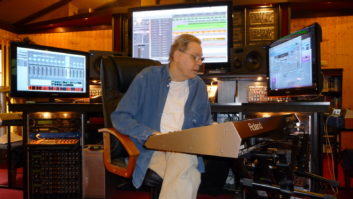74-year old Don Bryant is a soul legend, having been a powerhouse writing force behind the likes of Solomon Burke, Etta James, Albert King and many others. As other vocalists like Al Green caught the public’s eye with impressive and oftentimes innate vocal talents, Bryant moved away from the spotlight, opting to put his efforts into following his muse and finding the next line. Pro Sound News recently chatted with Bryant about his new album, Don’t Give Up On Love, a unique accomplishment sure to stand the test of time.
ON RETURNING TO THE STUDIO:
Howard Graham, who is the drummer of the Hi Rhythm Section, asked my producer, Scott Bomar, to give me a call to see what I had been up to. He did call, and we talked about making a new record. Eventually, Scott talked to the folks at Possum Records and after we all got together, I decided I would go ahead and try to do an album. Since it has come out, the response has been overwhelming [laughs]. I just don’t have words for it, and it has made me wonder why there was such a strong response. There are not many radio stations playing this kind of music, but I believe there are a lot of people out there who love this music and want to hear it.
ON NEVER STOPPING:
It wasn’t hard to do it again, because I never stopped writing or singing. When Scott asked me to do some shows with him and his band, I gave it a shot to make sure I was ready. I never doubted my own abilities though, because I have been continuously doing this for a long time—I love the music so much. I am not a piano player, but I can chord out the changes when I am singing. I will usually put down a track including keys, bass and drums and then do the lead singing. At home, I work with an eight-track digital recorder and record each of the instruments to the best of my ability [laughs]. After I put the lead vocal down, I will put a couple backing vocals down, just to make sure the idea doesn’t get away from me. If you don’t get the idea down, next thing you know, you are headed in another direction. In the beginning, little words and phrases just come to me, and then I will sit down and see if I can write a story about it.
Scott and some other folks said, ‘Why don’t you do some of the things that you wrote way back?” There are about four or five songs that I wrote on the album. I went all the way back to a song that I did for the Five Royales, “I Got To Know.” We just picked out these songs to use on the album, and I had no objection, because I wrote them.
ON BLOSSOMING AS A WRITER:
When I first started off singing, I would try to imitate all the artists as much as I could. I would study the songs, ideas and stories they were telling. When artists started coming into the studio at Hi Records, I kind of moved to the side because they were so strong, and people like Al Green had such great voices. I knew that I wasn’t going to be the main vocal artist because there were just too many great voices. But I had to be there because it was the love of my life—so I turned to writing. From that point on, anytime an artist came in, I wanted to make sure I had some material to present to them. I became more and more involved in writing that way, and I would always have something available. When I found a certain approach to writing songs, it became more and more exciting for me and I kept digging deeper and deeper.
As it kept building, there were other writers around in the studio, and I would see how they attacked things. We would put ideas together to create songs. It was very satisfying for me to know that my songs were good enough for someone else to record. My writing came from an accumulation of listening to songs, being around other writers, listening to ideas and trying to create a story from a couple of words. Rather than just rhyming words, I wanted to match different lines. I had to formulate my own way of working, and my way of working may not work for other people. Perhaps the most important thing was that I learned how to love what I was doing and I put a lot of my time into it.
ON TRACKING:
We recorded at Scott Bomar’s Electrophonic Recording Studio in Memphis, where I had done some demos before. As far as the recording was concerned, we used similar techniques that we used all those years ago. We wrote the songs, the musicians learned the songs and we just went in. Everybody played the songs all together, and then I would come in and do the voice overdubs. I had my family there for the recording: Charles Hodges [organ], Archie Turner [keyboard] and Howard Grimes [drums] from the Hi Rhythm Section. That made it feel like home for me, since we’d worked together so much over the years. The sessions never seemed long or drawn out, and everything went really smoothly.
One song that was really special for me was “How Do I Get There.” When I wrote that song, I really wanted to see how it would come out in a professional production. And they didn’t let me down—I was really happy. When we listened to the final mix over the monitors, I had my wife there with me, and it was overwhelming—mostly just to know that I was still able to record these songs well-enough for an album. That really made me happy.
Jacques Sonyieux is a devout explorer of recording studios and the artists that occasionally inhabit them. Please send any tips or feedback to Jacques at: [email protected].







